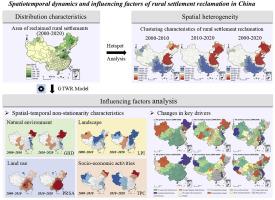Spatiotemporal dynamics and influencing factors of rural settlement reclamation in China from 2000 to 2020
IF 7
1区 经济学
Q1 DEVELOPMENT STUDIES
引用次数: 0
Abstract
To address the imbalances in rural human-land relationship amid rapid urbanization, the Chinese government has been undertaking extensive rural settlement reclamation efforts across the country since the 2000s. However, the spatiotemporal dynamics and influencing factors of these efforts remain unclear. This study analyzes the spatiotemporal distribution and influencing factors of rural settlement reclamation in China from 2000 to 2020 using spatiotemporal land use data and the Geographical and Temporal Weighted Regression (GTWR) model, achieving a satisfactory adjusted R2 of 0.8037. The research reveals significant progress in rural settlement reclamation, with approximately 34,589 km2 of rural settlement area reclaimed, primarily in the North China Plain, Northeast Plain, and northern Xinjiang. The regression results show that the key factors influencing reclamation include per capita rural settlement area, geological hazards density, rural population change, and per capita cultivated land area. This study also highlights the significant spatiotemporal non-stationarity of influencing factors such as per capita rural settlement area and geological hazards density across different regions and time periods. These findings provide a comprehensive understanding of the spatiotemporal evolution of rural settlement reclamation while offering crucial insights for policymakers. They highlight the importance of adaptive, region-specific strategies for rural land consolidation to promote sustainable development by harmonizing human-land relationships with population dynamics and economic considerations in rural areas.

2000 - 2020年中国农村聚落垦殖时空动态及影响因素
为了解决快速城市化中农村人地关系的不平衡,中国政府自2000年代以来在全国范围内开展了广泛的农村聚落复垦工作。然而,这些努力的时空动态和影响因素尚不清楚。利用时空土地利用数据和GTWR模型,对2000 - 2020年中国农村聚落垦殖的时空分布及其影响因素进行了分析,调整后的R2为0.8037,结果令人满意。研究表明,农村聚落复垦取得了显著进展,复垦面积约为34,589 km2,主要集中在华北平原、东北平原和新疆北部。回归结果表明,影响垦殖的关键因素包括农村人均聚落面积、地质灾害密度、农村人口变化和人均耕地面积。农村人均聚落面积、地质灾害密度等影响因素在不同区域、不同时段具有显著的时空非平稳性。这些发现提供了对农村聚落垦殖时空演变的全面理解,同时也为政策制定者提供了重要的见解。它们强调了农村土地整合的适应性、具体区域战略的重要性,通过协调人地关系与农村地区的人口动态和经济考虑来促进可持续发展。
本文章由计算机程序翻译,如有差异,请以英文原文为准。
求助全文
约1分钟内获得全文
求助全文
来源期刊

Habitat International
Multiple-
CiteScore
10.50
自引率
10.30%
发文量
151
审稿时长
38 days
期刊介绍:
Habitat International is dedicated to the study of urban and rural human settlements: their planning, design, production and management. Its main focus is on urbanisation in its broadest sense in the developing world. However, increasingly the interrelationships and linkages between cities and towns in the developing and developed worlds are becoming apparent and solutions to the problems that result are urgently required. The economic, social, technological and political systems of the world are intertwined and changes in one region almost always affect other regions.
 求助内容:
求助内容: 应助结果提醒方式:
应助结果提醒方式:


